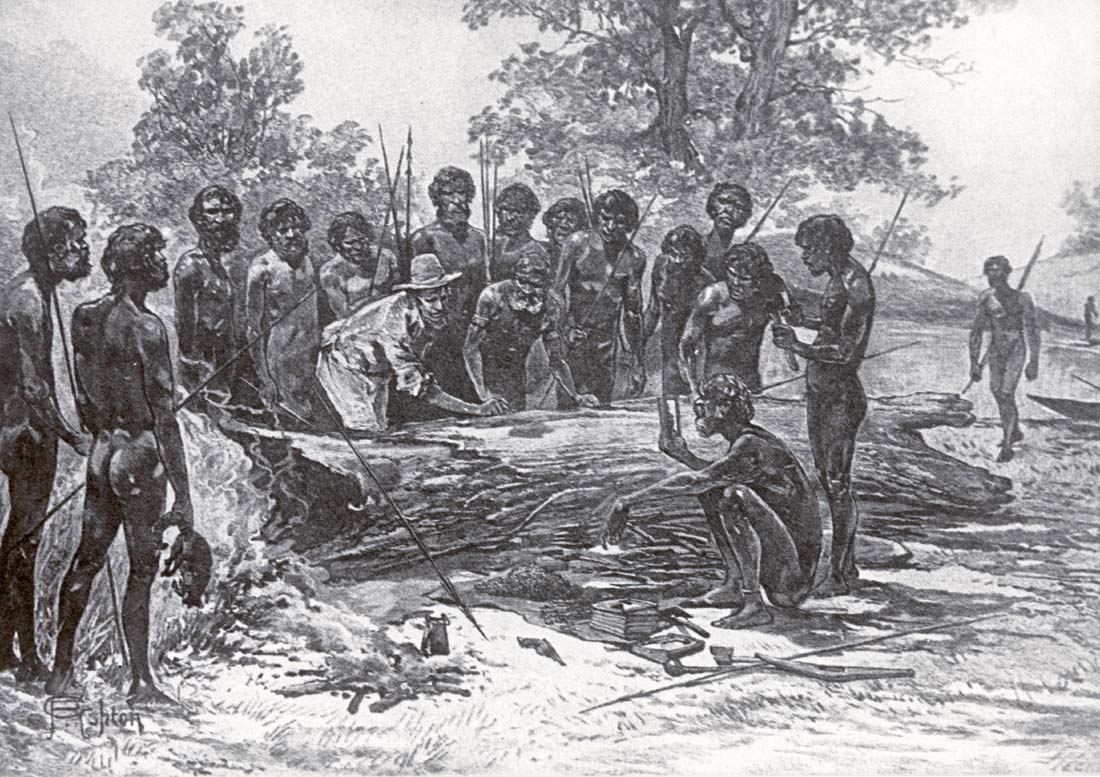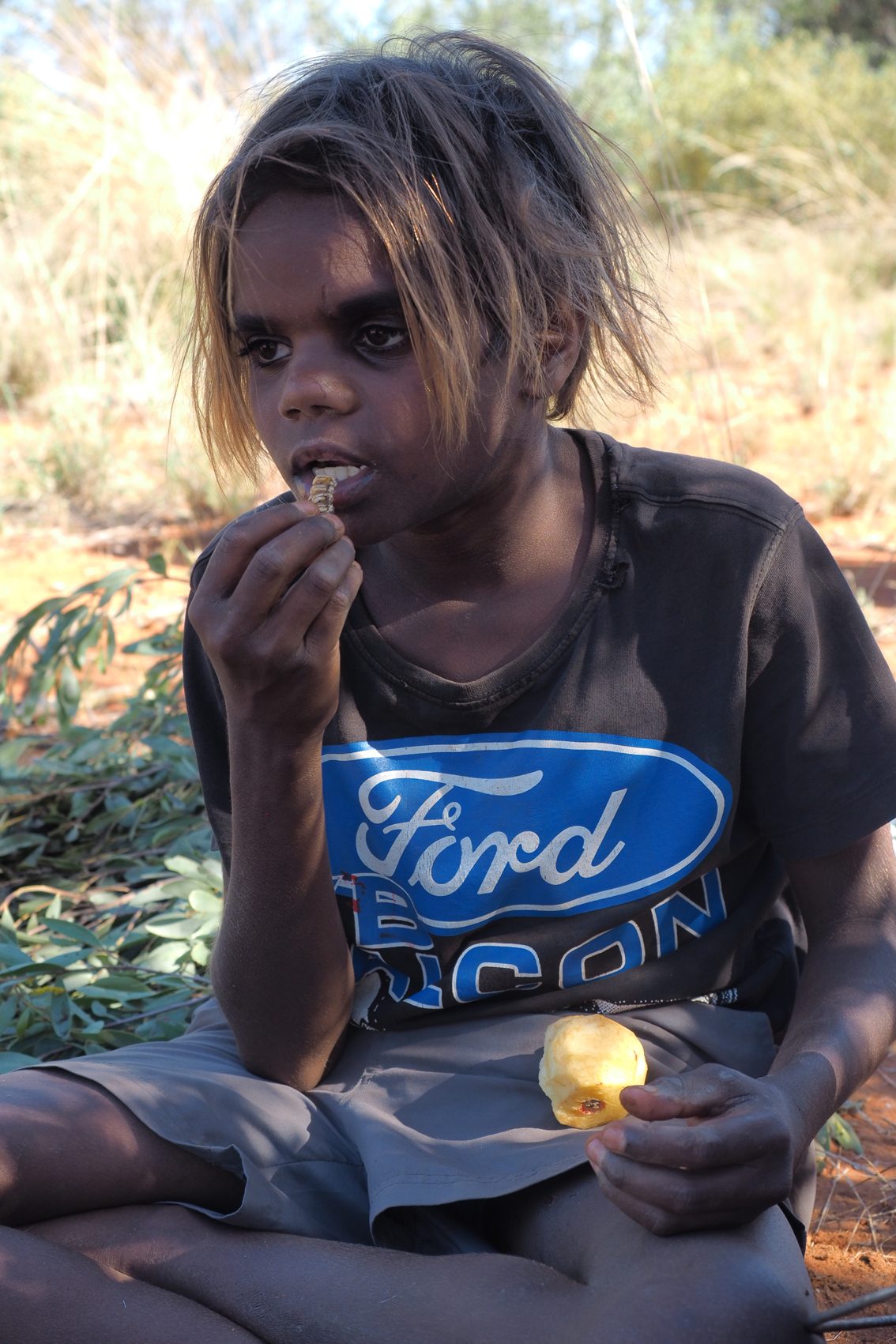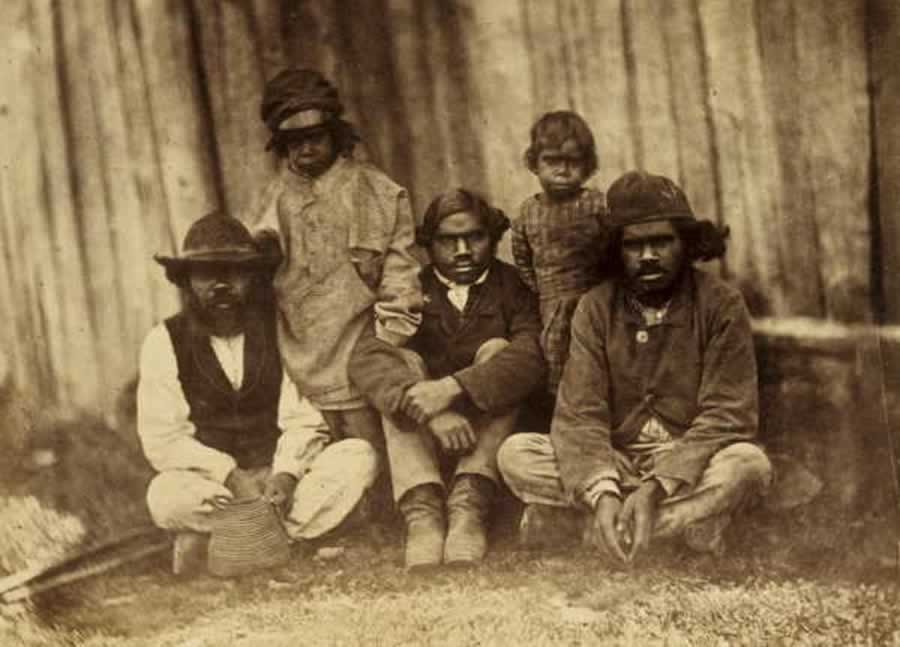|
Tanderrum
A tanderrum is an Aboriginal Australian ceremony enacted by the nations of the Kulin people and other Aboriginal Victorian nations allowing safe passage and temporary access and use of land and resources by foreign people. It was a diplomatic rite involving the landholder's hospitality and a ritual exchange of gifts, sometimes referred to as "Freedom of the Bush". Visiting people were presented to elders by an interim group known to all parties. Eucalypt leaves were used in the ceremony to indicate visitors were free to partake of the resources. Water was shared from a tarnuk, sipped through a reed straw, with the hosts partaking first to reassure the visitors that the water was not poisoned. The signing of Batman's Treaty in 1835 was likely to have been interpreted as a tanderrum ceremony by the Wurundjeri and Boon wurrung peoples, according to some historians. Certainly the Wurundjeri and Boon wurrung people continued to act with hospitality to the settlers in the first years o ... [...More Info...] [...Related Items...] OR: [Wikipedia] [Google] [Baidu] |
Wurundjeri
The Wurundjeri people are an Australian Aboriginal people of the Woiwurrung language group, in the Kulin nation. They are the Traditional Owners of the Birrarung (Yarra River) Valley, covering much of the present location of Narrm (Melbourne). They continue to live in this area and throughout Australia. They were called the Yarra tribe by early European colonists. The Wurundjeri Tribe Land and Compensation Cultural Heritage Council was established in 1985 by Wurundjeri people. Ethnonym According to the early Australian ethnographer Alfred William Howitt, the name Wurundjeri, in his transcription ''Urunjeri'', refers to a species of eucalypt, '' Eucalyptus viminalis'', otherwise known as the manna or white gum, which is common along Birrarung. Some modern reports of Wurundjeri traditional lore state that their ethnonym combines a word, ''wurun'', meaning ''Manna Gum'' and ''djeri'', a species of grub found in the tree, and take the word therefore to mean " Witchetty G ... [...More Info...] [...Related Items...] OR: [Wikipedia] [Google] [Baidu] |
Batman's Treaty
Batman's Treaty was an agreement between John Batman, an Australian grazier, businessman and coloniser, and a group of Wurundjeri elders, for the purchase of land around Port Phillip, near the present site of Melbourne. The document came to be known as Batman's Treaty and is considered significant as it was the first and only documented time when Europeans negotiated their presence and occupation of Aboriginal lands directly with the traditional owners.Richard Broome, pp10-14, ''Aboriginal Victorians: A History Since 1800'', Allen & Unwin, 2005, , The treaty was implicitly declared void on 26 August 1835 by the Governor of New South Wales, Richard Bourke. Making of the treaty In January 1827, John Batman and Joseph Gellibrand applied for a grant of land at Port Phillip,Joseph Gellibrand "Austral ... [...More Info...] [...Related Items...] OR: [Wikipedia] [Google] [Baidu] |
Foundation Of Melbourne
The city of Melbourne was founded in 1835. The exact circumstances of ''the foundation of Melbourne'', and the question of who should take credit, have long been matters of dispute. Exploration A series of colonisers, mostly operating from Sydney, explored the south-east coast of the Australian continent. In 1797 George Bass discovered Bass Strait, the passage between the Australian mainland and Van Diemen's Land (Tasmania); Bass sailed as far west as Western Port. Other navigators included James Grant in 1800. In 1802 John Murray in the '' Lady Nelson'' became the first recorded European to sail into Port Phillip, but he did not reach the northern end of the bay. He was followed shortly after by Matthew Flinders. In January 1803, Charles Robbins and Charles Grimes in the schooner '' Cumberland'' explored the whole of the bay, and found the mouth of the Yarra River, on which they rowed as far as Dights Falls at Collingwood. In October 1803 a convict settlement was establ ... [...More Info...] [...Related Items...] OR: [Wikipedia] [Google] [Baidu] |
Aboriginal Australian Ceremony
Australian Aboriginal culture includes a number of practices and ceremonies centered on a belief in the Dreamtime and other mythology. Reverence and respect for the land and oral traditions are emphasised. Over 300 languages and other groupings have developed a wide range of individual cultures. Due the colonization of Australia under terra nullius concept these cultures were treated as one monoculture. Australian Aboriginal art has existed for thousands of years and ranges from ancient rock art to modern watercolour landscapes. Aboriginal music has developed a number of unique instruments. Contemporary Australian Aboriginal music spans many genres. Aboriginal peoples did not develop a system of writing before colonisation, but there was a huge variety of languages, including sign languages. Oral tradition Cultural traditions and beliefs as well as historical tellings of actual events are passed down in Aboriginal oral tradition, also known loosely as oral history (although th ... [...More Info...] [...Related Items...] OR: [Wikipedia] [Google] [Baidu] |
Welcome To Country
A Welcome to Country is a ritual or formal ceremony performed as a land acknowledgement at many events held in Australia. It is intended to highlight the cultural significance of the surrounding area to the descendants of a particular Aboriginal clan or language group who were recognised as the original human inhabitants of the area. For the Welcome to be recognised as official, it must be performed by a recognised elder of the group. Welcomes to Country are sometimes accompanied by traditional smoking ceremonies, music or dance. Where an elder is not available to perform the Welcome, or there is not a recognised traditional owner, an Acknowledgement of Country may be offered instead. The term "Country" has a particular meaning and significance to many Aboriginal peoples, encompassing an inter-dependent relationship between an individual or a people and their ancestral or traditional lands and seas. The connection to land involves culture, spirituality, language, law/lore, k ... [...More Info...] [...Related Items...] OR: [Wikipedia] [Google] [Baidu] |
Indigenous Australian Politics
Indigenous Australians or Australian First Nations are people with familial heritage from, and membership in, the ethnic groups that lived in Australia before British colonisation. They consist of two distinct groups: the Aboriginal peoples of the Australian mainland and Tasmania, and the Torres Strait Islander peoples from the seas between Queensland and Papua New Guinea. The term Aboriginal and Torres Strait Islander peoples or the person's specific cultural group, is often preferred, though the terms First Nations of Australia, First Peoples of Australia and First Australians are also increasingly common; 812,728 people self-identified as being of Aboriginal and/or Torres Strait Islander origin in the 2021 Australian Census, representing 3.2% of the total population of Australia. Of these indigenous Australians, 91.4% identified as Aboriginal; 4.2% identified as Torres Strait Islander; while 4.4% identified with both groups. [...More Info...] [...Related Items...] OR: [Wikipedia] [Google] [Baidu] |
Dja Dja Wurrung
Dja Dja Wurrung (Pronounced Ja-Ja-war-rung), also known as the Djaara or Jajowrong people and Loddon River tribe, are an Aboriginal Australian people who are the Traditional owners of lands including the watersheds of the Loddon and Avoca rivers in the Bendigo region of central Victoria, Australia. They are part of the Kulin alliance of Aboriginal Victorian peoples. There are 16 clans, which adhere to a patrilineal system. Like other Kulin peoples, there are two moieties: Bunjil the eagle and Waa the crow. Name The Dja Dja Wurrung ethnonym is often analysed as a combination of a word for "yes" (''djadja'', dialect variants such as ''yeye'' /''yaya'', are perhaps related to this) and "mouth" (''wurrung''). This is quite unusual, since many other languages of the region define their speakers in terms of the local word for "no". It had, broadly speaking, two main dialects, an eastern and western variety. Language Dja Dja Wurrung is classified as one of the Kulin languages ... [...More Info...] [...Related Items...] OR: [Wikipedia] [Google] [Baidu] |
Joy Murphy Wandin
Joy Murphy Wandin is an Indigenous Australian, Senior Wurundjeri elder of the Kulin alliance in Victoria, Australia. She has given the traditional '' welcome to country'' greeting at many Melbourne events and to many distinguished visitors where she says in the Woiwurrung language "''Wominjeka Wurundjeri Balluk yearmenn koondee bik''" ("Welcome to the land of the Wurundjeri people").Martin Flanagan, Tireless ambassador bids you welcome', The Age, 25 January 2003. Retrieved 31 October 2008 Born in Healesville, Joy Murphy Wandin's family never left Wurundjeri land and she is the great-great niece to William Barak, the last ''traditional'' ngurungaeta of the Wurundjeri-willam clan. Her older brother (Juby) James Wandin, who once played football with St Kilda Football Club in the 1950s, was the ngurungaeta of the Wurundjeri until his death in February 2006. Her father, Jarlo Wandoon, tried to enlist for World War 1, but was rejected due to being an Aboriginal person. When he ... [...More Info...] [...Related Items...] OR: [Wikipedia] [Google] [Baidu] |
Herring Island (Victoria)
Herring Island is a small artificial island located in Melbourne's Yarra River at South Yarra, approximately from the city centre. It is the only island in the Yarra River. Herring Island was formed in 1928 by cutting a channel through an old basalt quarry. The island was leased for many years by the scout movement, who named it after their patron, Sir Edmund Herring, the Lieutenant-Governor of Victoria and Chief Justice of the Supreme Court of Victoria. The Island contains indigenous vegetation, and provides important habitat for native fauna, particularly birds. It is currently managed by Parks Victoria and used as a sculpture park. Sculptures include works by Jill Peck, Ellen Jose, and Andy Goldsworthy. History Herring Island is an artificial island that was formed in 1928 by cutting a new path for the Yarra River through an old basalt quarry, as part of a plan to control flooding of the river. The new island, which was initially called Como Island, was built up with silt ... [...More Info...] [...Related Items...] OR: [Wikipedia] [Google] [Baidu] |
Ellen Jose
Ellen is a female given name, a diminutive of Elizabeth, Eleanor, Elena and Helen. Ellen was the 609th most popular name in the U.S. and the 17th in Sweden in 2004. People named Ellen include: *Ellen Adarna (born 1988), Filipino actress *Ellen Alaküla (1927–2011), Estonian actress * Ellen Palmer Allerton (1835–1893), American poet *Ellen Allien (born 1969), German electronic musician and music producer *Ellen Anckarsvärd (1833-1898), Swedish feminist *Ellen Andersen (1898–1989), Danish museum curator *Ellen Anderson (born 1959), American politician *Ellen Auerbach (1906–2004), German-born American photographer *Ellen Baake (born 1961), German mathematical biologist *Ellen S. Baker (born 1953), American physician and astronaut *Ellen Barkin (born 1954), American actress *Ellen Bass (born 1947), American poet and author *Ellen A. Dayton Blair (1837–1926), social reformer and art teacher *Ellen Bontje (born 1958), Dutch equestrian *Ellen Burka (1921–2016), Dutch and ... [...More Info...] [...Related Items...] OR: [Wikipedia] [Google] [Baidu] |
Indigenous Australian
Indigenous Australians or Australian First Nations are people with familial heritage from, and membership in, the ethnic groups that lived in Australia before British colonisation. They consist of two distinct groups: the Aboriginal peoples of the Australian mainland and Tasmania, and the Torres Strait Islander peoples from the seas between Queensland and Papua New Guinea. The term Aboriginal and Torres Strait Islander peoples or the person's specific cultural group, is often preferred, though the terms First Nations of Australia, First Peoples of Australia and First Australians are also increasingly common; 812,728 people self-identified as being of Aboriginal and/or Torres Strait Islander origin in the 2021 Australian Census, representing 3.2% of the total population of Australia. Of these indigenous Australians, 91.4% identified as Aboriginal; 4.2% identified as Torres Strait Islander; while 4.4% identified with both groups. [...More Info...] [...Related Items...] OR: [Wikipedia] [Google] [Baidu] |
William Thomas (Australian Settler)
William Thomas (29 April 1794 – 1 December 1867) represented Aboriginal people in various roles in the Port Phillip district (now known as the state of Victoria) in Australia. Early life William Thomas was born on 29 April 1794 in Westminster, London. His father was an officer in the British army under Sir Ralph Abercrombie and died in the Battle of Alexandria in 1801. Thomas's formal education was concluded at 21 with a year on the continent, spent mainly in Spain and Gibraltar. With little capital or prospects for patronage, he founded a successful school located in Southwark on the Old Kent Road in south-east London. There he trained young men for entry to the civil service. Thomas's achievements as an educator and his devout Methodism brought him to the attention of the post- Reform Act government. Assistant Protector Thomas was one of four Assistant Protectors of Aborigines appointed by Lord Glenelg, Colonial Secretary of State, in the Port Phillip district t ... [...More Info...] [...Related Items...] OR: [Wikipedia] [Google] [Baidu] |





